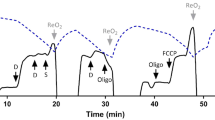Abstract
The mitochondria isolated from the muscles of fish acclimated to grow in different salinities have been studied with reference to their Ca2+ uptake capacity and compared to those isolated from fresh-water fish muscle. The results show a drastic response by the mitochondria with reference to their Ca2+ uptake function soon after exposure to the stress. Evidence is also presented to suggest an alteration in conformation. This perturbation appears to be the initial response to the stress since the normal state (as that of the fresh-water fish) is restored in course of time. Further, so far there is no indication that the electron transport function and ATP production are affected by the ionic stress conditions. This would support the physiological relevance of the mitochondrial capacity for Ca2+ uptake.
Similar content being viewed by others
References
G. V. Honnappa, R. H. Sulochana, and J. Jayaraman,J. Bioenergetics 7 (1975) 149.
O. H. Lowry, N. J. Rosenbrough, A. L. Farr, and R. S. Randall,J. Biol. Chem. 193 (1951) 265.
B. Reynfarje and A. L. Lehninger,J. Biol. Chem. 244 (1969) 584.
F. P. Conte,Fish Physiology, Vol. I, W. S. Hoar, and D. J. Randall, (eds.), Academic Press, London, (1969) p. 241.
W. J. Holmes and E. N. Donaldson, inFish Physiology, Vol. I, W. S. Hoar and D. J. Randall (eds.), Academic Press, London, (1969) p. 1.
H. Hensel and G. Hildebrandt, inHandbook of Physiology, Section 4, C. G. Wilber (ed.), American Physiological Society, Washington D.C., (1964) p. 73.
J. O. Holloszy,Medicine and Science in Sports 7(3), (1975) 155.
C. R. Hickman and B. F. Trump, inFish Physiology, Vol. I, W. L. Hoar and D. J. Randall (eds.), Academic Press, New York, (1969) p. 91.
O. Kinne,Nether. J. Sea. Res. 3 (1966) 222.
C. L. Prosser, inMolecular mechanisms of temperature adaptation C. L. Prosser (ed.), American Association for the Advancement of Science, Washington D.C., (1967) p. 351.
C. S. Rossi, E. Carafoli, Z. Drahota, and A. L. Lehninger, inRegulation of Metabolic Processes in Mitochondria J. M. Tager, S. Papa, E. Quagliariello, E. C. Slater (eds.), Elsevier Publishing Co., Amsterdam (1966) p. 329.
A. L. Lehninger,Ann. N.Y. Acad. Sci. 137 (1966) 700.
H. Dransfeld, K. Great, A. Schorn, and B. T. Ting,Biochem. Pharmacol 18 (1969) 1335.
E. Carafoli,Biochemie Extrait du Tome 55 (1973) 755.
E. Carafoli,Biochem. Soc. Symposium 39 (1974) 89.
Author information
Authors and Affiliations
Rights and permissions
About this article
Cite this article
Sulochana, H.R., Bashyam, I., Narayan, S. et al. Physiological correlates of calcium-accumulating properties of mitochondria: Fish-muscle mitochondria. J Bioenerg Biomembr 9, 337–348 (1977). https://doi.org/10.1007/BF00743149
Received:
Issue Date:
DOI: https://doi.org/10.1007/BF00743149




